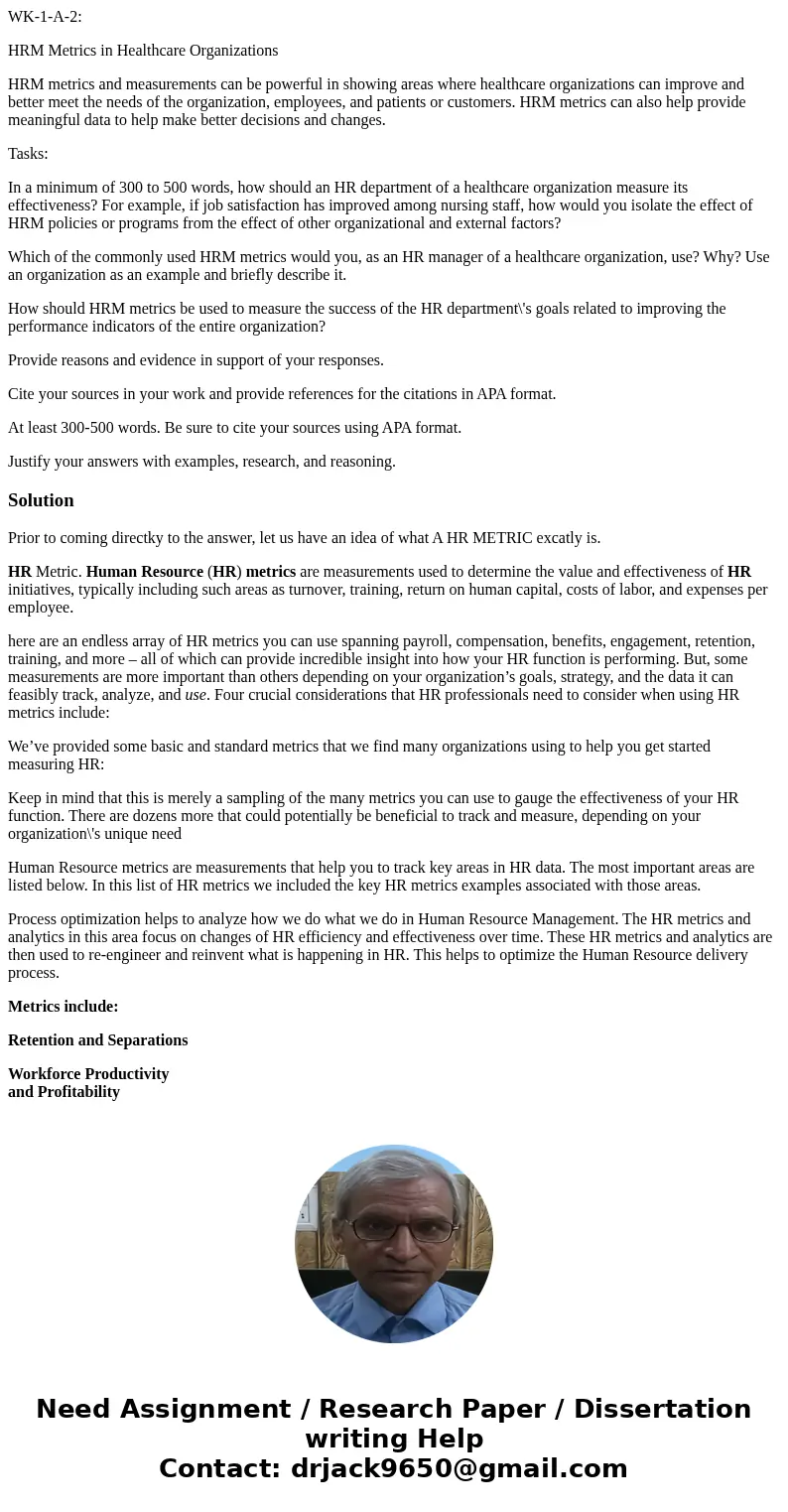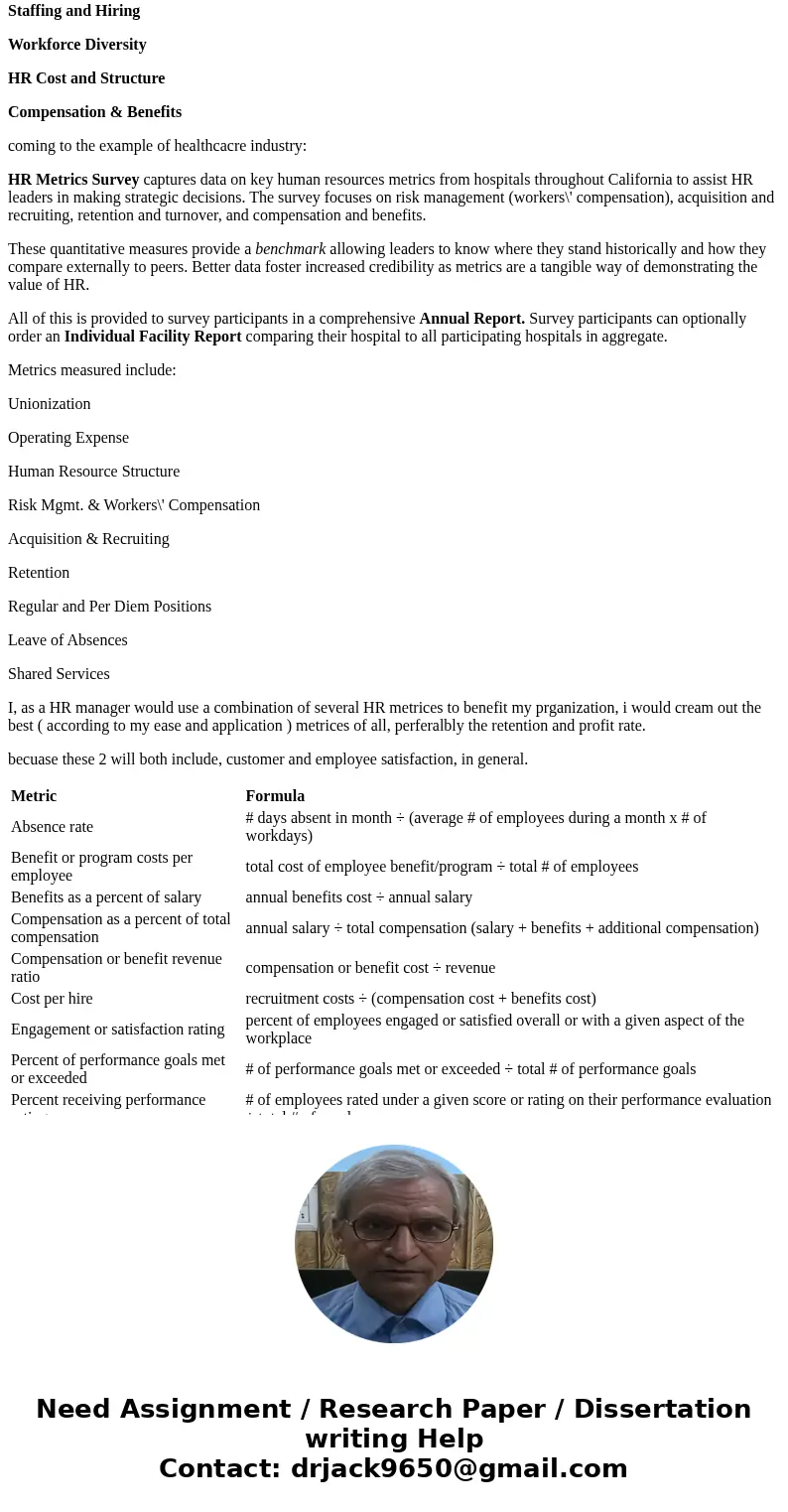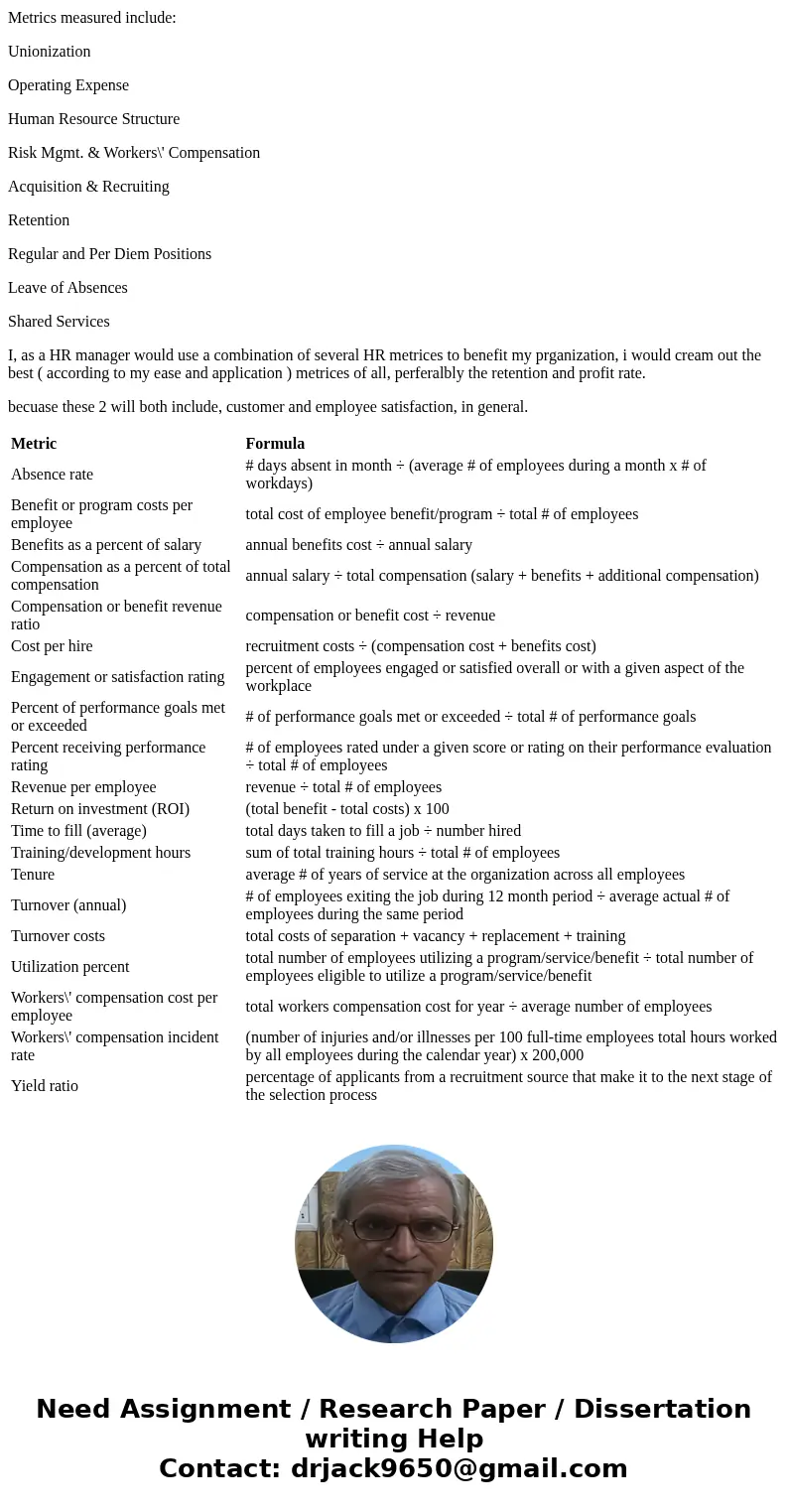WK1A2 HRM Metrics in Healthcare Organizations HRM metrics an
WK-1-A-2:
HRM Metrics in Healthcare Organizations
HRM metrics and measurements can be powerful in showing areas where healthcare organizations can improve and better meet the needs of the organization, employees, and patients or customers. HRM metrics can also help provide meaningful data to help make better decisions and changes.
Tasks:
In a minimum of 300 to 500 words, how should an HR department of a healthcare organization measure its effectiveness? For example, if job satisfaction has improved among nursing staff, how would you isolate the effect of HRM policies or programs from the effect of other organizational and external factors?
Which of the commonly used HRM metrics would you, as an HR manager of a healthcare organization, use? Why? Use an organization as an example and briefly describe it.
How should HRM metrics be used to measure the success of the HR department\'s goals related to improving the performance indicators of the entire organization?
Provide reasons and evidence in support of your responses.
Cite your sources in your work and provide references for the citations in APA format.
At least 300-500 words. Be sure to cite your sources using APA format.
Justify your answers with examples, research, and reasoning.
Solution
Prior to coming directky to the answer, let us have an idea of what A HR METRIC excatly is.
HR Metric. Human Resource (HR) metrics are measurements used to determine the value and effectiveness of HR initiatives, typically including such areas as turnover, training, return on human capital, costs of labor, and expenses per employee.
here are an endless array of HR metrics you can use spanning payroll, compensation, benefits, engagement, retention, training, and more – all of which can provide incredible insight into how your HR function is performing. But, some measurements are more important than others depending on your organization’s goals, strategy, and the data it can feasibly track, analyze, and use. Four crucial considerations that HR professionals need to consider when using HR metrics include:
We’ve provided some basic and standard metrics that we find many organizations using to help you get started measuring HR:
Keep in mind that this is merely a sampling of the many metrics you can use to gauge the effectiveness of your HR function. There are dozens more that could potentially be beneficial to track and measure, depending on your organization\'s unique need
Human Resource metrics are measurements that help you to track key areas in HR data. The most important areas are listed below. In this list of HR metrics we included the key HR metrics examples associated with those areas.
Process optimization helps to analyze how we do what we do in Human Resource Management. The HR metrics and analytics in this area focus on changes of HR efficiency and effectiveness over time. These HR metrics and analytics are then used to re-engineer and reinvent what is happening in HR. This helps to optimize the Human Resource delivery process.
Metrics include:
Retention and Separations
Workforce Productivity
and Profitability
Staffing and Hiring
Workforce Diversity
HR Cost and Structure
Compensation & Benefits
coming to the example of healthcacre industry:
HR Metrics Survey captures data on key human resources metrics from hospitals throughout California to assist HR leaders in making strategic decisions. The survey focuses on risk management (workers\' compensation), acquisition and recruiting, retention and turnover, and compensation and benefits.
These quantitative measures provide a benchmark allowing leaders to know where they stand historically and how they compare externally to peers. Better data foster increased credibility as metrics are a tangible way of demonstrating the value of HR.
All of this is provided to survey participants in a comprehensive Annual Report. Survey participants can optionally order an Individual Facility Report comparing their hospital to all participating hospitals in aggregate.
Metrics measured include:
Unionization
Operating Expense
Human Resource Structure
Risk Mgmt. & Workers\' Compensation
Acquisition & Recruiting
Retention
Regular and Per Diem Positions
Leave of Absences
Shared Services
I, as a HR manager would use a combination of several HR metrices to benefit my prganization, i would cream out the best ( according to my ease and application ) metrices of all, perferalbly the retention and profit rate.
becuase these 2 will both include, customer and employee satisfaction, in general.
| Metric | Formula |
| Absence rate | # days absent in month ÷ (average # of employees during a month x # of workdays) |
| Benefit or program costs per employee | total cost of employee benefit/program ÷ total # of employees |
| Benefits as a percent of salary | annual benefits cost ÷ annual salary |
| Compensation as a percent of total compensation | annual salary ÷ total compensation (salary + benefits + additional compensation) |
| Compensation or benefit revenue ratio | compensation or benefit cost ÷ revenue |
| Cost per hire | recruitment costs ÷ (compensation cost + benefits cost) |
| Engagement or satisfaction rating | percent of employees engaged or satisfied overall or with a given aspect of the workplace |
| Percent of performance goals met or exceeded | # of performance goals met or exceeded ÷ total # of performance goals |
| Percent receiving performance rating | # of employees rated under a given score or rating on their performance evaluation ÷ total # of employees |
| Revenue per employee | revenue ÷ total # of employees |
| Return on investment (ROI) | (total benefit - total costs) x 100 |
| Time to fill (average) | total days taken to fill a job ÷ number hired |
| Training/development hours | sum of total training hours ÷ total # of employees |
| Tenure | average # of years of service at the organization across all employees |
| Turnover (annual) | # of employees exiting the job during 12 month period ÷ average actual # of employees during the same period |
| Turnover costs | total costs of separation + vacancy + replacement + training |
| Utilization percent | total number of employees utilizing a program/service/benefit ÷ total number of employees eligible to utilize a program/service/benefit |
| Workers\' compensation cost per employee | total workers compensation cost for year ÷ average number of employees |
| Workers\' compensation incident rate | (number of injuries and/or illnesses per 100 full-time employees total hours worked by all employees during the calendar year) x 200,000 |
| Yield ratio | percentage of applicants from a recruitment source that make it to the next stage of the selection process |



 Homework Sourse
Homework Sourse